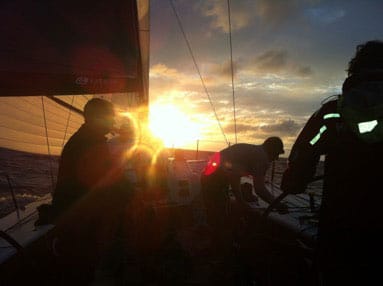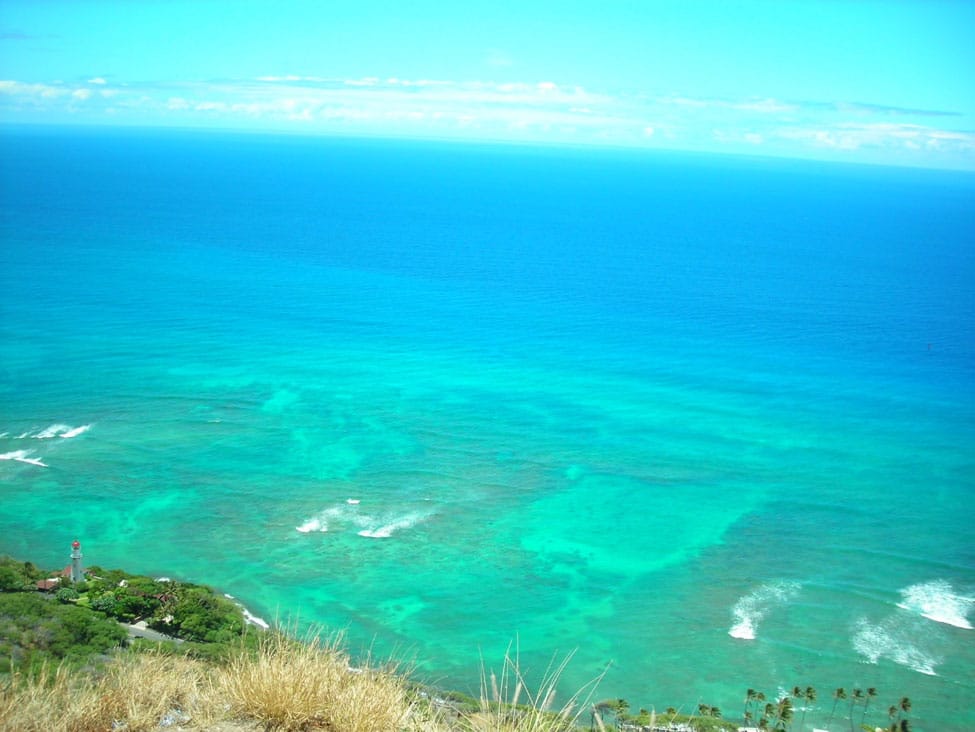
The brochure for any yacht race to Hawaii is compelling for anyone with the slightest desire to go to sea. It reads: “Do one of the world’s greatest ocean races with your sailing friends. Sail hundreds of downwind, trade wind miles under a big spinnaker, wearing only smiles, board shorts and a T-shirt. Sail into the sunset day after day, toward welcome parties, hula dancers, mai-tais, surfing, family, friends and comfortable beds.” What the brochure doesn’t tell you, however, is that a race to Hawaii is a transformative personal experience.
Think about it. For long stretches of the race, you are hundreds of miles from land in any direction, not quite Point Nemo, but close. The closest humans outside your boat could very well be astronauts 249 miles above, orbiting in the International Space Station. There is something unique and mystical about being a tiny speck on a vast ocean. Being in the middle of nowhere can help you find yourself, gaining a better sense of how small you are in the universe as you gaze at more stars than you ever knew existed.
The daily routine is refreshingly simple — sail, eat, sleep, repeat — which provides a complete break from your everyday struggles, challenges and to-do lists. Expect some of your clearest thinking; figuring out what truly matters in your life – and, just as importantly, what doesn’t.
A Hawaii race is not just a leisurely passage, though. It can also be the source of significant stress, at least for the skipper and navigator. Cut the corner on the Pacific High too close and end up in hot sunshine with little to no wind while your competitors sail right around you in more wind. But you can overcompensate as well by sailing too much extra distance.
Navigator extraordinaire Stan Honey has a clue for when you’ve sailed too close around the high: “The butter starts melting.”

There’s also the same anxiety inshore tacticians experience when calling laylines to marks they can actually see, but magnified exponentially given the distances involved. Consider here that the final layline for a Hawaii race can exceed 1,000 nautical miles with windshifts more than 20 degrees.
The final layline is no joke.
Imagine the embarrassment of jibing too late and overstanding, forcing your teammates to sail long distances under a blast reacher (or worse… a jib) while your competitors are trucking under A2 or S2 spinnakers straight into the finish. Jibe too early and end up under-standing the finish mark, coming in way short and having to sail low and slow for miles or jibe back and forth on comparatively unfavored angles. Even if you’re fortunate to have nailed the final layline, you still spend hours alternating between worrying you’ve over-stood or under-stood given that periods of different pressure and windshifts will mess with your heading on such a long layline. This is part of why they call these races navigators’ races.
Now finally imagine the thrill, or the terror, of stepping up to the helm in 20 to 30 knots of wind on the leading edge of a squall with the boat totally lit up, flying downwind, through the pitch-black night with no horizon for orientation. We’ve all seen those larger than life sailors that can drive in anything. Are you one?
Will you grab the wheel when it is crazy or will you be content to trim or grind or sleep down below?
Hawaii races are won by the teams that have great night fighters. The boat has to go at peak speeds 24 hours a day and doesn’t care how little you slept, how wet you may be, or when your watch is over; it just wants to be driven or it will wipe out, resulting in an oversized yard sale. After getting your safety harness clipped, and getting acclimated to the hairy downwind, dark conditions, standing next to the existing driver, you eventually have to say, “OK, I got it.”
And the helm is yours, but do you really have it? Let’s race the Pacific.

For any serious yacht racer, the bucket list is sure to include the Transpac, raced in odd numbered years and organized by the Transpacific Yacht Club. The course is rated at 2,225 nautical miles, which exceeds the actual distance recognizing that boats will have to sail a bit more distance than the rhumbline to swing around the North Pacific High. The Transpac is the racer’s race, which was first held in 1906, a remarkable fact given the California Gold Rush took place not too long before Hawaii had recently become a territory of the United States and the Titanic hadn’t even been built.
Emphasizing the prominence that the race has historically had, President Theodore Roosevelt triggered the start canon in 1908. Sailors recognize that to simply finish the Transpac is a major accomplishment. Even Matt Hooper in the movie Jaws (played by Richard Dreyfuss) tries to establish his credentials by saying that he’s crewed in three Transpacs. For those dream of doing more than finishing, a podium spot in a division of Transpac is a significant accomplishment. Aside from the elapsed time records that Jim Clark’s 100-footer Comanche is gunning for this summer, most elite race teams and their owners covet the two main prizes: a massive 3 foot by 4 1/2-foot carved slab of koa wood called the Barn Door Trophy (first monohull to finish- manual power) and the King Kalakaua Trophy (first monohull on corrected time).
Lined up on the Transpac start line of the race are some of the biggest, baddest yachts to be found in the United States; from 100-foot maxis, TP52s, sleds, state of the art multihulls, all the way down to the family cruisers. For amateur sailors, it’s fantasy camp to be sailing against professionals from the America’s Cup, Volvo Ocean Race and the Olympics. Sailing is amazing from the perspective that every day people can compete with and against top professional sailors.

The Transpac boasts an enviable history and lore with legendary programs taking their place in the winner’s circle such as: Pyewacket, Grand Illusion, Merlin, Pegasus, Alfa Romeo, Morning Glory, Silver Bullet, Bella Mente, Morning Star, Ticonderoga, Kialoa, Windward Passage, Ragtime, and Cheval. The Transpac saw the birth of the venerable Cal 40s, TP52s and the ultralight-downwind flyers like Merlin, which led to the 70-foot Sled class. The Transpac has also provided the platform for the epic maxi match race duels between navigator legends Stan Honey and Mark Rudiger; bore witness to Mir sailing backward over the finish line in 1969 with a spinnaker flown off the mizzenmast; and saw Cheval steam past Diamond Head light under jury rig to narrowly hang on to the 1995 Barn Door Trophy win after dismasting 25 nautical miles from the finish.
As with any race, part of the magic lies with the start and finish locations, and Transpac is no exception. Rainbow Harbor in Long Beach is the center of gravity for the Transpac pre-race activities, which among other things, is home to the Transpac Walk of Fame, honoring famous participants from years past. There is something special about being able to walk the docks and see, up close and personal, some of the sweetest sailing rockets, lined up and ready to cross an ocean. Then on your start day, you motor out toward Point Fermin with fanfare including a fireboat spraying water high into the air. After the start, the Transpac has only one mark, leave Catalina Island to port.
And, of course, the finish of a Transpac is paradise. For hundreds of miles, you imagine crossing that finish line near Diamond Head Lighthouse near the R2 Buoy right off the reef. The finish is a welcome rest after hurtling down the big wind, big wave funnel called the Molokai Channel. Transpac saves the biggest challenge of the race for the end when you are good and tired to make you earn the right to say that you’ve completed a Transpac. Hopefully, you arrive during the day and you get to view Oahu’s spectacular scenery.
Once you finish, it’s sails down and a motor into the Ala Wai Harbor. While docking, every finish boat is announced and the gathered crowds cheer. After clearing the race administration and inspections, it’s over to the tents. Each boat is sponsored by a local Hawaiian business which throws an awesome welcome party, regardless of the time of arrival. After getting re-acclimated to life back on shore, it’s time to go to the prize giving ceremony at the Modern Hotel and celebrate the victors, the finishers, the stories and the close of another installment of one of the world’s greatest ocean races.
Christopher “Lew” Lewis navigated yachts to class wins, records, and even the overall podium in three crewed Hawaii races (Vic-Maui, Transpac, and Pacific Cup). In the most recent Vic Maui Race (2016), Lewis was awarded the Captain George Vancouver Navigator’s trophy for his work on *Kinetic V, a TP52, whose team was first in class, first overall and was one of three boats that broke the elapsed time record. Lew is a tech executive (General Counsel) of a cloud software company based in San Francisco and also a dedicated lifelong learner, currently only one course short of becoming an alumni of the Harvard Business School. Lewis will navigate Frank Slootman’s brand new Pac 52, the Invisible Hand, in this summer’s 2017 Transpac.*









